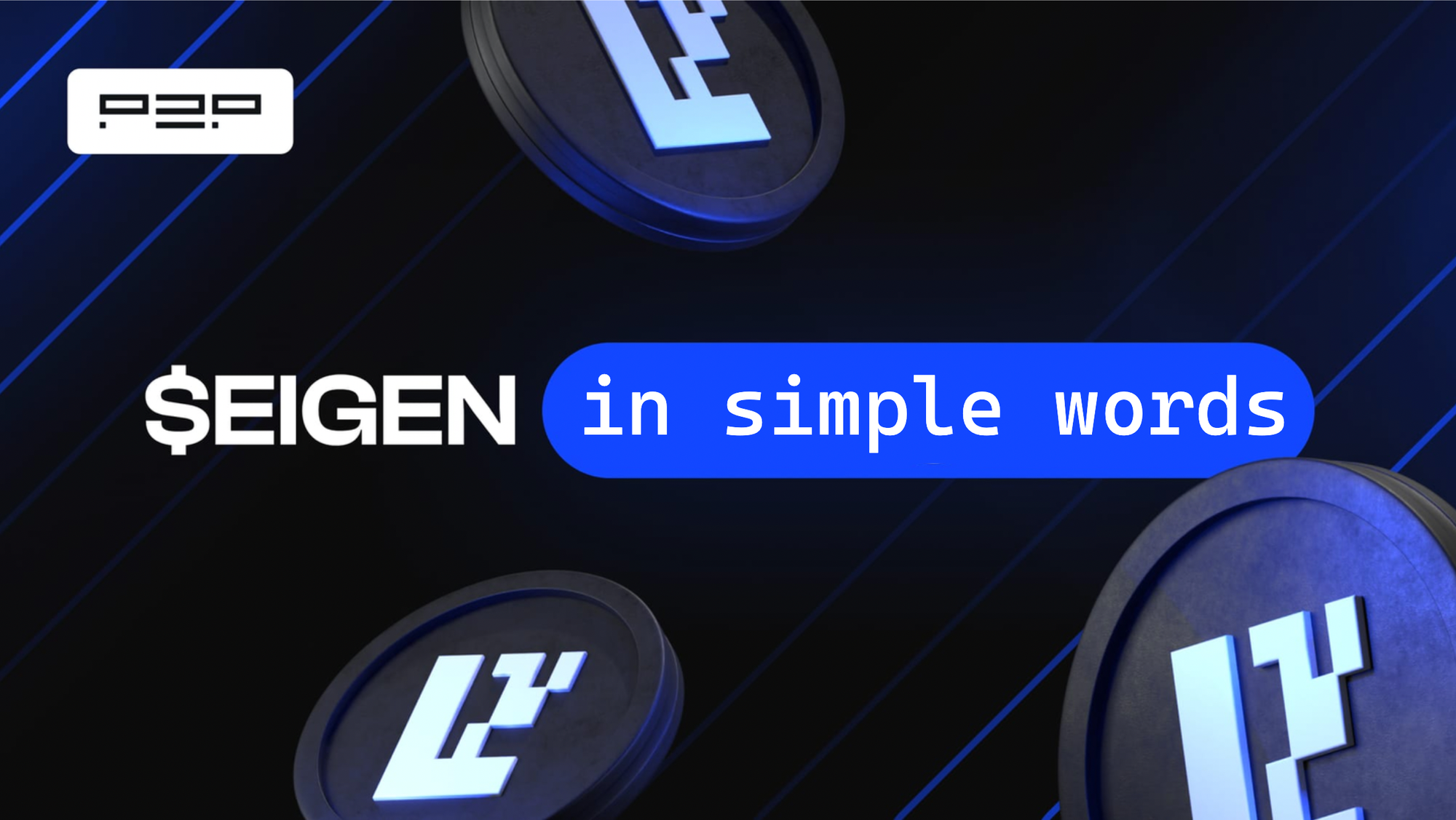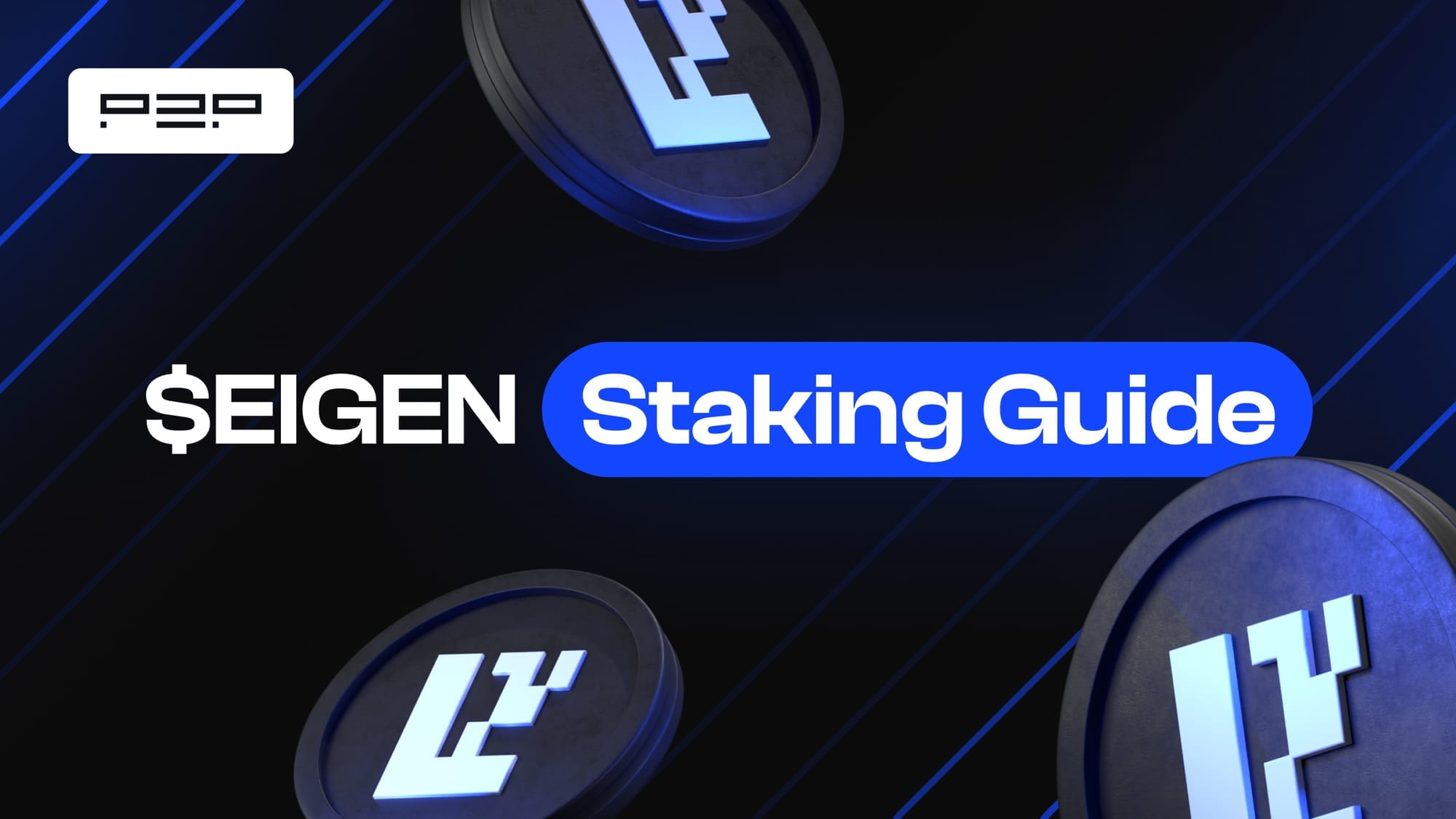Subscribe to P2P-economy
Stay up to date! Get all the latest & greatest posts delivered straight to your inbox
Subscribe
On April 29, EigenLayer introduced the $EIGEN, which has a unique token design and utility. We dived deeper to explain intersubjective faults, how tokens may be forkable, and the nature of $bEIGEN.
Before discussing $EIGEN and its design, it's essential to understand some concepts introduced by EigenLayer.
The main idea behind any decentralized network or service is trustlessness. This means you don't need a central supervisor. Instead, the network's nodes work together to verify each other's work. If a node breaks the network rules, it gets punished through a process called slashing. For example, if an Ethereum validator creates two different blocks simultaneously, it's considered an attempt to split the network into two forks, and the validator is punished by slashing.
Decentralized services rely on the ability to verify if nodes violate network rules and punish bad behavior. However, not all types of bad behavior are easy to verify and punish. EigenLayer divides bad behavior (faults) into two types:
ETH restaking provides a way to penalize objective faults, extending Ethereum's security to other protocols. The new $EIGEN token introduces a mechanism specifically designed to address intersubjective faults.
$EIGEN works like staking, where slashing is imposed through mechanisms similar to formalized social disputes because these slashing conditions cannot be tracked on-chain. Another analogy is governance: voting for or against proposals to charge malicious actors. You can read more about objective and intersubjective faults in the white paper.
The purposes of $EIGEN are:
What are some usecases of AVSs with intersubjective slashing @eigenlayer
— Sreeram Kannan (@sreeramkannan) May 8, 2024
---------------
1) EigenDA - to slash for data withholding (not onchain verifiable)
2) Ordering service - to slash for censorship (not onchain verifiable)
3) Validity on arbitrary VM - to slash for… https://t.co/uvhGHdDWwJ
$EIGEN is represented in two forms: bEIGEN and EIGEN, both of which are ERC-20 tokens that can be interchanged.
The purpose of having two representations is to simplify the process and avoid complications related to forking. If there were only one token, every forking event would require DeFi platforms and CEXes to register a new fork and supply liquidity, which is inconvenient.
Now, let’s imagine that some AVS adopted $EIGEN to secure intersubjective slashing conditions. This AVS defines the mechanism for how the intersubjective slashing will work, i.e., conditions, dispute periods, voting design, etc. Here’s a step-by-step explanation of the forking process when an operator commits an intersubjective fault:

You can read all details about token allocation and check your eligibility on the official site https://eigenfoundation.org/ Here is a summary
The total supply of EIGEN at launch is 1,673,646,668.28466 tokens.

Notable that In the initial phase, the $EIGEN will be non-transferable and non-forkable. That means you can’t trade it and get slashing. According to the EigenLayer plans, we can expect enabling transferability by the end of Q3 after the following milestones:
EigenLayer announced the plans to empower decentralization and distribute 8.95% more of the initial token supply for ecosystem participation before the token become transferable and forkable (so approx. next four months).
One of the few options to participate in the ecosystem right now is by staking $EIGEN. Since the token is currently non-transferable, staking is the only available action. By staking $EIGEN, you will help secure EigenDA and other upcoming intersubjective AVSs.
To get started with staking $EIGEN, check out our step-by-step staking guide in our detailed article.

Ethereum Product Manager at P2P.org
<p>We have exciting news that will boost your staking returns!</p><p>From <strong>June 1st to June 30th</strong>, we’re launching a special promotion to reduce fees to an incredible <strong>0.5%</strong> for a select group of our validators in the Polkadot network. With our dynamic fee structure, you can enjoy better returns and a more rewarding staking experience.</p><p><strong>What’s New:</strong></p><ul><li><strong>Dynamic Fee Structure:</strong> We’re temporarily lowering the fees to <strong>0.5%</strong> for a subset of our validators. This subset changes approximately monthly, so you can always access <a href="http://p2p.org/?ref=p2p.org">P2P.ORG</a> validators with reduced costs.</li><li><strong>Better Returns:</strong> With lower fees during this promo period, you can earn more from your staking.</li><li><strong>Monthly Rotating Low-Fee Validators:</strong> A new set of <a href="http://p2p.org/?ref=p2p.org">P2P.ORG</a> validators will be chosen monthly. This ensures you can always stake with low-fee validators, regardless of when you start staking.</li><li><strong>Fair and Transparent:</strong> We’re all about transparency. The rotation of low-fee validators will be clear and balanced, and each <a href="http://p2p.org/?ref=p2p.org">r</a>otation will be announced on <a href="http://p2p.org/?ref=p2p.org">P2P.org</a> communities on Telegram and Twitter. Stay tuned!</li></ul><p><strong>How It Works:</strong></p><ul><li>From <strong>June 1st to June 30th</strong>, take advantage of the <strong>0.5%</strong> fee with these validators:</li></ul><div class="kg-card kg-callout-card kg-callout-card-blue"><div class="kg-callout-emoji">💡</div><div class="kg-callout-text">13uW7auWPX9WAtqwkBx7yagb78PLcv8FAcPZEVCovbXoNJK4 12ud6X3HTfWmV6rYZxiFo6f6QEDc1FF74k91vF76AmCDMT4j 145Vw57NN3Y4tqFNidLTmkhaMLD4HPoRtU91vioXrKcTcirS</div></div><ul><li>At the start of each month, we’ll announce the new validators with reduced fees for the next period. The current validators’ fees will then return to our standard rate (4.5% as of May 2024).</li></ul><p>Remember, this reduced fee is a special promotion and not permanent. Make sure to take advantage of it while it lasts!</p><p>We’re thrilled about these changes and believe they’ll make a significant difference for you. Thank you for being part of the <a href="http://p2p.org/?ref=p2p.org">P2P.ORG</a> community and for your continued support.</p><p>If you have any questions or want to discuss this further, our support team is here to help.</p><p>Happy Staking!</p><h1 id="about-p2p-validator"><strong>About P2P Validator</strong></h1><p><a href="https://p2p.org/?ref=p2p.org">P2P Validator</a> is a world-leading non-custodial staking provider, securing over $7 billion from over 10,000 delegators/nominators across 40+ high-class networks. We have actively participated in the Polkadot/Kusama network since the beginning.</p><hr><p>Do not hesitate to ask questions in our <a href="https://t.me/P2Pstaking?ref=p2p.org">Telegram</a> chat or contact Alex via <a href="mailto:[email protected]">[email protected]</a>. We are always open to communication.</p><hr><p><strong>Web:</strong> <a href="https://p2p.org/?ref=p2p.org">https://p2p.org</a></p><p><strong>Stake DOT with us:</strong> <a href="https://p2p.org/polkadot?ref=p2p.org">https://p2p.org/polkadot</a></p><p><strong>Twitter:</strong> <a href="https://twitter.com/p2pvalidator?ref=p2p.org">@p2pvalidator</a></p><p><strong>Telegram:</strong> <a href="https://t.me/P2Pstaking?ref=p2p.org">https://t.me/P2Pstaking</a></p>
from p2p validator
<p>EIGEN stakedrop claims are open. Season 1 starts with 6.05% of the initial supply ready to claim. Eigen Foundation has already announced the next stakedrop season plans and is considering distributing 8.95% of the initial token supply for ecosystem participation.</p><p>This guide will explain how to participate in the ecosystem and secure EigenDA and other AVS that will soon accept $EIGEN as staking collateral.</p><h1 id="how-to-choose-the-operator-for-eigen">How to choose the operator for $EIGEN</h1><p>While $EIGEN can secure ONLY EigenDA it doesn't matter how many AVS supports your operator (because your $EIGEN stake won't participate in securing other AVS except EigenDA). A few considerations to take into account: </p><ol><li>It's important that the operator plans to onboard more AVS using $EIGEN, which is coming according to EigenLayer announcements. </li><li>you can delegate all your staked assets only to one operator, including restated natively ETH, LST, and $EIGEN. Therefore, if you already opted in for some operator previously, you don't need to do that again; after depositing $EIGEN to the EigenLayer smart contracts, it will be automatically delegated to an operator you have already chosen. </li><li>since you can't choose separate operators for your restaked ETH and $EIGEN, in case you have restaked $ETH it makes sense to opt-in operator best suited both for restaked ETH and restaked $EIGEN</li></ol><h1 id="two-options-if-you-decided-to-stake-with-p2porg">Two options if you decided to stake with P2P.org</h1><p></p><ol><li><a href="https://app.eigenlayer.xyz/operator/0xb585cb192855253d33ddbdac2d20f50085ef8d41?ref=p2p.org">Renzo x P2P.org operator</a> for ONLY $EIGEN restaking. - supports all intersubjective AVSes. It's only EigenDA now, but expecting more in the near future. On top of that, this operator has an additional incentive from our partner <a href="https://app.renzoprotocol.com/portfolio?ref=p2p.org" rel="noreferrer">Renzo</a> - 100 ezPoints for every 100 $EIGEN staked.<br><br>How to restake with P2P x Renzo operator -> <a href="https://p2p.org/economy/eigen-staking-guide-with-p2p/#:~:text=by%2Dstep%20guide-,1.Renzo%20x%20P2P.org,-operator%20for%20ONLY" rel="noreferrer"><strong>step-by-step guide</strong></a><br></li><li><a href="https://app.eigenlayer.xyz/operator/0xdbed88d83176316fc46797b43adee927dc2ff2f5?ref=p2p.org">P2P.org [all AVS]</a> operator for ETH and $EIGEN restaking. It doesn't have a Renzo ezPoints incentive, but supports all AVS securing both your ETH and $EIGEN stake, thus maximizing your farming opportunities. <br><br>How to restake with this operator P2P.org[all AVS] -> <a href="https://p2p.org/economy/eigen-staking-guide-with-p2p/#:~:text=staked%20with%20Renzo.-,2.P2P.org%20%5Ball%20AVS%5D,-operator%20for%20ETH" rel="noreferrer"><strong>step-by-step guide</strong></a></li></ol><h1 id="1renzo-x-p2porg-operator-for-only-eigen-staking-guide">1.Renzo x P2P.org operator for ONLY $EIGEN staking guide</h1><p>We proudly announce that we are partnering with Renzo to provide users with better UX and increase farming opportunities. Renzo makes staking your $EIGEN and giving you ezPoints as incentive while <a href="http://p2p.org/?ref=p2p.org">P2P.org</a> ensures validator infrastructure uptime and manages associated risks of securing EigenDA</p><p>1.Check eligibility & claim $EIGEN <a href="https://claims.eigenfoundation.org/?ref=p2p.org">https://claims.eigenfoundation.org/</a>. You have to connect the wallet and accept the Terms to do that. Note you will need to turn off the VPN to do that.</p><figure class="kg-card kg-image-card"><img src="https://p2p.org/economy/content/images/2024/05/image.png" class="kg-image" alt="" loading="lazy" width="2000" height="1150" srcset="https://p2p.org/economy/content/images/size/w600/2024/05/image.png 600w, https://p2p.org/economy/content/images/size/w1000/2024/05/image.png 1000w, https://p2p.org/economy/content/images/size/w1600/2024/05/image.png 1600w, https://p2p.org/economy/content/images/2024/05/image.png 2000w" sizes="(min-width: 720px) 720px"></figure><ol start="2"><li>Go to Renzo dApp and connect wallet <a href="https://app.renzoprotocol.com/portfolio?ref=p2p.org">https://app.renzoprotocol.com/portfolio</a></li></ol><figure class="kg-card kg-image-card"><img src="https://p2p.org/economy/content/images/2024/05/image-1.png" class="kg-image" alt="" loading="lazy" width="2000" height="1041" srcset="https://p2p.org/economy/content/images/size/w600/2024/05/image-1.png 600w, https://p2p.org/economy/content/images/size/w1000/2024/05/image-1.png 1000w, https://p2p.org/economy/content/images/size/w1600/2024/05/image-1.png 1600w, https://p2p.org/economy/content/images/2024/05/image-1.png 2000w" sizes="(min-width: 720px) 720px"></figure><ol start="3"><li>Stake your $EIGEN. You will need to sign three txs to do that. </li></ol><figure class="kg-card kg-image-card"><img src="https://p2p.org/economy/content/images/2024/05/image-2.png" class="kg-image" alt="" loading="lazy" width="2000" height="1114" srcset="https://p2p.org/economy/content/images/size/w600/2024/05/image-2.png 600w, https://p2p.org/economy/content/images/size/w1000/2024/05/image-2.png 1000w, https://p2p.org/economy/content/images/size/w1600/2024/05/image-2.png 1600w, https://p2p.org/economy/content/images/2024/05/image-2.png 2000w" sizes="(min-width: 720px) 720px"></figure><ol start="4"><li>Receive 100 ezPoints for every 100 $EIGEN staked with Renzo.</li></ol><h1 id="2p2porg-all-avs-operator-for-eth-and-eigen-staking-guide">2.P2P.org [all AVS] operator for ETH and $EIGEN staking guide</h1><p>1.Check eligibility & claim $EIGEN <a href="https://claims.eigenfoundation.org/?ref=p2p.org">https://claims.eigenfoundation.org/</a>. You have to connect the wallet and accept the Terms to do that. Note you will need to turn off VPN to do that.</p><figure class="kg-card kg-image-card"><img src="https://p2p.org/economy/content/images/2024/05/image.png" class="kg-image" alt="" loading="lazy" width="2000" height="1150" srcset="https://p2p.org/economy/content/images/size/w600/2024/05/image.png 600w, https://p2p.org/economy/content/images/size/w1000/2024/05/image.png 1000w, https://p2p.org/economy/content/images/size/w1600/2024/05/image.png 1600w, https://p2p.org/economy/content/images/2024/05/image.png 2000w" sizes="(min-width: 720px) 720px"></figure><ol start="2"><li>After you claim tokens visit <a href="https://app.eigenlayer.xyz/restake/EIGEN?ref=p2p.org" rel="noopener noreferrer">https://app.eigenlayer.xyz/restake/EIGEN</a> and enter the amount that you'd like to deposit and push delegate button </li></ol><figure class="kg-card kg-image-card"><img src="https://docs.eigenlayer.xyz/assets/images/stake-eigen-one-0e44816b1ad8ca47935414e9c671bfb4.png" class="kg-image" alt="" loading="lazy" width="2562" height="1440"></figure><ol start="3"><li>Once the deposit is successful, click on the Delegate button. (If you have restaked ETH and you have already delegated it to an operator, you're done - your EIGEN is automatically delegated to that same operator)</li></ol><figure class="kg-card kg-image-card"><img src="https://docs.eigenlayer.xyz/assets/images/stake-eigen-two-2c6ec74c0ae8b9572b267ae935463ff6.png" class="kg-image" alt="" loading="lazy" width="2559" height="1438"></figure><ol start="4"><li>Go to P2P.org [all AVS] delegator's page <br><a href="https://app.eigenlayer.xyz/operator/0xdbed88d83176316fc46797b43adee927dc2ff2f5?ref=p2p.org">https://app.eigenlayer.xyz/operator/0xdbed88d83176316fc46797b43adee927dc2ff2f5</a></li><li>Click Delegate to initiate a delegation.</li></ol><figure class="kg-card kg-image-card"><img src="https://p2p.org/economy/content/images/2024/05/image-3.png" class="kg-image" alt="" loading="lazy" width="2000" height="1167" srcset="https://p2p.org/economy/content/images/size/w600/2024/05/image-3.png 600w, https://p2p.org/economy/content/images/size/w1000/2024/05/image-3.png 1000w, https://p2p.org/economy/content/images/size/w1600/2024/05/image-3.png 1600w, https://p2p.org/economy/content/images/2024/05/image-3.png 2000w" sizes="(min-width: 720px) 720px"></figure><h1 id="stakedrop-eigenlayer-faq">Stakedrop EigenLayer FAQ </h1><figure class="kg-card kg-bookmark-card"><a class="kg-bookmark-container" href="https://docs.eigenfoundation.org/?ref=p2p.org"><div class="kg-bookmark-content"><div class="kg-bookmark-title">Overview | EigenFoundation</div><div class="kg-bookmark-description">What is a stakedrop? An airdrop designed for EIGEN staking. Learn more about staking here.</div><div class="kg-bookmark-metadata"><img class="kg-bookmark-icon" src="https://docs.eigenfoundation.org/img/favicon.ico" alt=""><span class="kg-bookmark-author">EigenFoundation Logo</span></div></div><div class="kg-bookmark-thumbnail"><img src="https://docs.eigenfoundation.org/img/meta_banner.png" alt=""></div></a></figure>
from p2p validator